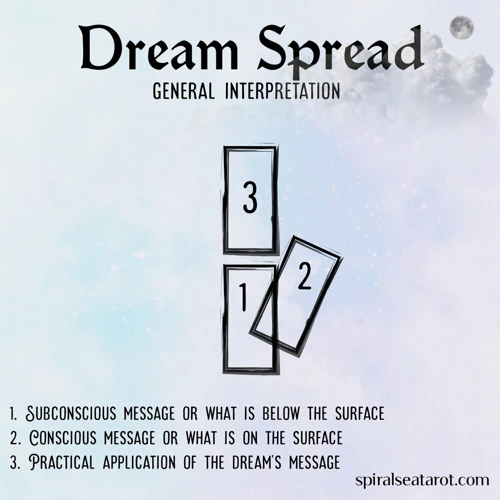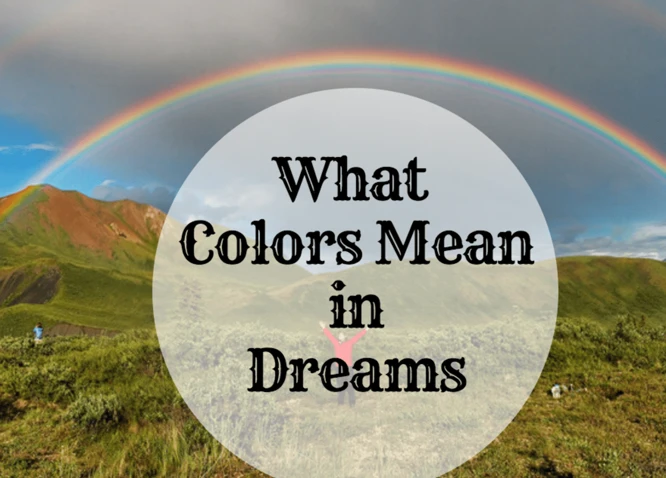Dreams have always fascinated and intrigued humans, offering a glimpse into the depths of our subconscious. They are a mysterious realm where our thoughts, fears, and desires manifest in symbolic forms. One crucial aspect of dreams is the presence of vibrant colors that add depth and meaning to our experiences while asleep. Colors play a significant role in our waking lives, influencing our emotions and perceptions. However, their importance in interpreting lucid dream symbols is often overlooked. In this article, we will delve into the mesmerizing world of dream symbolism and explore the profound impact of colors on the messages our dreams convey.
The Role of Colors in Dreams

Colors hold immense power and significance in dreams, acting as a language of the subconscious mind. When we dream, our brain creates vivid images, and these images are often infused with various colors. Each color has its own unique energy and symbolism, which adds layers of meaning to the dream experience. Red can represent passion, anger, or vitality, while blue may denote calmness, tranquility, or sadness. Green signifies growth, harmony, and healing, while yellow symbolizes joy, happiness, and intellect. Purple is often associated with spirituality, mysticism, and creativity, while white represents purity, clarity, and new beginnings. Understanding the significance of these colors in dreams can provide valuable insights into our emotional states, desires, and inner struggles. By recognizing and interpreting the role of colors in our dreams, we can unlock a deeper understanding of ourselves and gain valuable guidance for our waking lives. To further explore the symbolic meanings of colors in lucid dreams, click here.
1. The Power of Colors
The power of colors in dreams cannot be underestimated. Each color carries its own unique energy and has the ability to evoke specific emotions and reactions within us. When we dream, the colors we encounter can have a profound impact on our subconscious mind. Red, with its vibrant and intense hue, can ignite feelings of passion, excitement, and even anger. It symbolizes both love and danger. Blue, on the other hand, has a calming effect and can bring about a sense of tranquility, peace, and serenity. It’s often associated with feelings of sadness or melancholy as well. Green represents growth, harmony, and balance. It can signify new beginnings, healing, and a connection to nature. Yellow, with its bright and sunny nature, is often linked to joy, happiness, optimism, and intellectual pursuits. Purple, a color often associated with spirituality and mysticism, can evoke feelings of mystery, creativity, and spiritual awakening. Lastly, white, the color of purity and innocence, can symbolize clarity, new beginnings, and a sense of purity. The power of colors in dreams is a fascinating aspect of dream interpretation, and understanding their meanings can provide valuable insights into our subconscious thoughts and emotions. To learn more about the symbolism of animals in lucid dreams, click here.
2. Color Symbolism
Color symbolism is a fascinating aspect of dream interpretation that involves understanding the deeper meanings behind specific colors. Every color has its own symbolism and can evoke different emotions and associations. For example, red is often associated with passion, power, and strong emotions, while blue represents calmness, peace, and spirituality. Green, on the other hand, signifies growth, renewal, and harmony with nature. Yellow is associated with happiness, positivity, and intellectual pursuits. Purple has long been symbolic of spirituality, creativity, and transformation, while white represents purity, innocence, and clarity. It’s important to note that individual interpretations may vary, and personal experiences and cultural backgrounds can influence the symbolic meanings of colors in dreams. Understanding color symbolism in dreams can provide valuable insights into our emotions, desires, and subconscious thoughts. To explore the symbolic meaning of water in lucid dreams, click here.
Interpreting Lucid Dream Symbols

Interpreting lucid dream symbols is like deciphering a secret language of the subconscious. Dreams are filled with symbols that often represent hidden meanings and messages. To fully understand these symbols, it’s crucial to develop a keen sense of self-awareness and reflection. Understanding symbols in dreams involves paying attention to recurring themes, personal experiences, and emotions that arise during the dream state. Keeping a dream journal can be immensely helpful in identifying patterns and recurring symbols. Once you have a clear understanding of the symbols in your dreams, you can begin to explore their significance. The significance of color in dream symbols cannot be underestimated. Colors in dreams often evoke certain emotions and have innate symbolic meanings. For example, a red object in a dream may represent passion or anger, while a blue object could symbolize calmness or sadness. By analyzing the colors in your dream symbols, you can gain deeper insights into the underlying emotions and messages your subconscious is conveying. It’s important to remember that dream interpretation is highly personal, and symbols can vary in meaning from person to person. Trusting your intuition and reflecting on your own experiences are key to unlocking the hidden messages within your dreams. For a deeper exploration of how symbols in dreams can guide us, click here.
1. Understanding Symbols in Dreams
Understanding symbols in dreams is an essential skill when it comes to interpreting the messages our subconscious mind is trying to convey. Dreams are often filled with vivid and sometimes bizarre imagery that may seem unrelated to our waking lives. However, every image and symbol in a dream holds a deeper meaning. Symbols can represent emotions, experiences, desires, fears, or even unresolved conflicts. The key to understanding dream symbols is to approach them with an open mind and a willingness to explore their personal significance. Dreams can be highly subjective, so it’s important to consider your own thoughts, feelings, and experiences when interpreting symbols. Keeping a dream journal can help you recognize patterns and recurring symbols, allowing you to form a more comprehensive understanding of their meaning. Additionally, exploring common dream symbols and their interpretations can provide valuable insights into your own unique dream language. By honing your ability to understand symbols in dreams, you can better decipher the messages your subconscious mind is trying to communicate.
2. The Significance of Color in Dream Symbols
The significance of color in dream symbols cannot be understated. Colors in dreams have the power to evoke strong emotions and elicit specific responses from our subconscious minds. Each color carries its own unique symbolism and meaning, which can vary from person to person based on cultural, personal, and even situational factors. For example, the color red may symbolize passion and intensity for one individual, while for another it may represent anger or danger. Similarly, the color blue could represent tranquility and peace for one dreamer, but for someone else, it may signify sadness or a feeling of being overwhelmed. By paying attention to the colors present in our dreams, we can gain valuable insights into our emotional state, unresolved issues, and even receive guidance or warnings about future events. It is essential to consider the context, personal associations, and intuitive feelings towards the colors present in dream symbols. This can be done by journaling your dreams and noting the colors that stand out, and then reflecting on the emotions and thoughts they evoke within you. By deciphering the significance of color in dream symbols, we can unlock a deeper understanding of ourselves and our dreams, leading to personal growth and self-awareness.
Common Dream Colors and Their Meanings

In the realm of dreams, colors hold profound symbolism and can provide valuable insights into our subconscious mind. Let’s explore the meanings behind some of the most common dream colors:
Red is a color often associated with strong emotions such as passion, desire, and anger. In dreams, it can represent intense feelings, whether positive or negative. It may indicate excitement, love, or even aggression. Pay attention to the context of the dream and your emotional response to understand the specific meaning of red in your dream.
Blue is a soothing and calming color often associated with serenity, tranquility, and emotions of a more peaceful nature. In dreams, blue can symbolize a sense of relaxation, contentment, or even sadness. It may indicate a need for emotional healing or a desire for inner peace.
Green is the color of nature, symbolizing growth, freshness, and harmony. When green appears in dreams, it often represents balance, abundance, and renewal. It may indicate personal growth, healing, or a need to connect with nature and find inner peace.
Yellow is a vibrant and cheerful color associated with joy, happiness, and intellectual energy. When yellow appears in a dream, it can symbolize optimism, creativity, and mental stimulation. It may indicate a new idea, a burst of inspiration, or a need to express yourself intellectually.
Purple is a color often associated with spirituality, mystery, and creativity. In dreams, purple can symbolize a connection to the spiritual realm, psychic abilities, or the exploration of one’s subconscious mind. It may indicate a need for self-reflection, creative expression, or a desire for spiritual growth.
White is a color often associated with purity, innocence, and new beginnings. When white appears in dreams, it can symbolize clarity, purification, or a fresh start. It may indicate the need for a clean slate, a desire to let go of the past, or a sense of newfound clarity in a particular aspect of your life.
By understanding the meanings behind common dream colors, we can gain deeper insights into the messages our dreams are trying to convey and use this knowledge to navigate our waking lives with greater understanding.
1. Red
Red is a powerful and dynamic color often associated with intense emotions and vibrant energy. When red appears in dreams, it can represent a wide range of meanings depending on the context. In some cases, red may symbolize passion, desire, or love. It can signify strong emotions, such as anger or aggression. Red is also commonly associated with vitality, courage, and power. Additionally, red can serve as a warning sign, indicating danger or potential harm. It is essential to consider the specific details and circumstances surrounding the presence of red in a dream to gain a deeper understanding of its meaning. For example, dreaming of seeing a red rose may suggest romantic love, while dreaming of blood could represent a sense of fear or vulnerability. The interpretation of red in a dream is highly subjective and can vary based on personal experiences and associations. However, it is important to pay attention to the emotions and sensations evoked by the color red in order to uncover its symbolic significance within the dream narrative.
2. Blue
Blue is a color that often evokes a sense of calmness and tranquility in our waking lives, and its presence in dreams is no different. When the color blue appears in a dream, it carries with it various symbolic meanings. One interpretation of blue in dreams is that it represents emotions and feelings of serenity, peace, and relaxation. It can reflect a need for emotional stability and a desire for a sense of calm in one’s life. Blue can also symbolize communication, clarity, and self-expression. In dreams, a blue sky or body of water may signify a sense of freedom, expansiveness, and limitless possibilities. Additionally, blue can represent a connection to the spiritual realm and intuition. It is essential to consider the context and personal associations one has with the color blue when interpreting its meaning in dreams. Understanding the symbolism of blue can help to unravel the deeper messages and emotions that our dreams are trying to convey.
3. Green
Green is a color that frequently appears in dreams and holds significant symbolism. In the realm of dream interpretation, green represents growth, harmony, and balance. When green is prevalent in a dream, it may suggest that there are elements of our lives that need nurturing and attention to facilitate personal growth and development. Green is often associated with nature and the environment, signifying a deep connection with the natural world and a desire for a harmonious relationship with it. It can also symbolize healing and rejuvenation, indicating a need for emotional or physical restoration. Green in dreams can represent abundance, fertility, and prosperity, suggesting that we may be entering a season of abundance and growth in our waking lives. Additionally, green may indicate that we are experiencing a sense of balance and equilibrium, in both our internal and external worlds. It can serve as a reminder to find harmony within ourselves and seek balance in all aspects of our lives, be it work, relationships, or personal well-being. By paying attention to the presence of green in our dreams, we can gain insights into areas of growth, balance, and harmony that may require our attention and nurturing.
4. Yellow
The color yellow holds a vibrant and energetic symbolism within our dreams. When yellow appears in a dream, it often represents joy, positivity, and enthusiasm. This sunny hue is associated with intellect, creativity, and mental activity. Yellow can symbolize the activation of ideas, inspiration, and the pursuit of knowledge. It is also linked to communication and self-expression. In dreams, yellow can manifest in various forms, such as yellow flowers, yellow objects, or even a golden glow. Seeing yellow in a dream may indicate that you are in a state of happiness, optimism, or you may be experiencing a burst of creative energy. It can also serve as a reminder to embrace positivity and radiate warmth and confidence in your waking life. Additionally, yellow can symbolize the need for clarity and focus, urging you to pay attention to details and make wise decisions. Understanding the significance of yellow in dream symbolism can help you uncover hidden messages and harness the power of this vibrant color.
5. Purple
The color purple in dreams carries a deep and mystical significance. It is often associated with the realm of spirituality, transformation, and creativity. When purple appears in a dream, it may indicate that the dreamer is exploring their spiritual path or going through a transformative phase in their life. Purple can symbolize the blending of opposing forces and the integration of different aspects of oneself. It represents a harmonious union between mind and spirit, where intuition and logic are in balance. In some cases, purple may also signify magical or supernatural elements present in the dream. It is a color that sparks inspiration and encourages creative endeavors. If you frequently dream of purple, it could be a sign to embrace your artistic side and explore your imagination. Purple in dreams invites us to tap into our spiritual potential and embrace the enchanting mysteries of life. To learn more about the symbolic meanings of color in dreams, you can read the article about Water Symbolism in Lucid Dreams.
6. White
In lucid dreams, the color white holds profound symbolism and significance. It often represents purity, innocence, and new beginnings. White can signify a blank slate, a fresh start, or a sense of clarity and purification. When white appears prominently in a dream, it may indicate a need for cleansing or letting go of negative emotions and experiences. This color can also symbolize spiritual awakening, enlightenment, and higher consciousness. In some instances, white may represent the presence of guiding spirits or divine beings. It is associated with feelings of peace, tranquility, and serenity. In dreams where white is present, pay attention to the emotions and sensations it evokes, as they can provide valuable insights into your spiritual journey and personal growth.
Color Combinations and Dream Interpretation
Color combinations in dreams can provide valuable insights and enhance the interpretation of dream symbols. Just as colors have individual meanings, their combinations bring forth even deeper symbolism. Warm colors, such as red and orange, evoke feelings of passion and energy. They can signify intense emotions or a heightened sense of urgency within a dream. In contrast, cool colors like blue and green often represent calmness and tranquility. These colors might indicate a need for relaxation or a peaceful resolution to a situation. Complementary colors, such as red and green, can symbolize balance or a need for harmony between opposing forces. Similarly, colors that clash, like red and blue, may reflect inner conflicts or contrasting aspects of one’s personality. Analyzing these color combinations can provide a more comprehensive understanding of the dream’s messages and assist in navigating the complexities of dream interpretation.
1. Warm vs. Cool Colors
When analyzing dream symbols, it is essential to consider the distinction between warm and cool colors. Warm colors include hues like red, orange, and yellow, which evoke feelings of energy, passion, and intensity. In dreams, warm colors often represent strong emotions, excitement, and even the presence of danger or warning signs. For example, seeing a red object in a dream could symbolize anger or a sense of urgency. On the other hand, cool colors encompass shades such as blue, green, and purple, which elicit feelings of calmness, serenity, and relaxation. Dreams with cool colors may indicate a sense of peace, tranquility, or a need for inner reflection. For instance, encountering a soothing blue landscape in a dream could signify a state of emotional balance or a desire for harmony. By understanding the dynamic between warm and cool colors in dreams, one can discern the emotional context and significance of dream symbols more accurately.
2. Complementary Colors
Complementary colors play a fascinating role in dream interpretation, as they bring an extra layer of dynamism and contrast to dream symbols. Complementary colors are pairs of colors that are opposite to each other on the color wheel. For example, red and green, blue and orange, and yellow and purple are complementary color pairs. When these colors appear together in a dream, they often represent a harmonious balance or a clash of opposing forces. The juxtaposition of complementary colors can indicate the need for integration or resolution in the dreamer’s life. For instance, a dream featuring the combination of red and green may suggest a need to balance passion and calmness, while blue and orange may symbolize a conflict between emotional stability and creativity. By paying attention to the presence of complementary colors in dreams, one can gain a deeper understanding of the dynamic forces at play in their waking life. It is worth exploring and reflecting upon the significance of complementary color combinations to unravel the hidden messages within the dream realm.
Conclusion
In conclusion, colors play a crucial role in interpreting lucid dream symbols. They hold immense power and symbolism, offering insights into our emotions, desires, and subconscious mind. By understanding the meanings behind different colors in dreams, we can gain a deeper understanding of ourselves and our waking lives. Whether it’s the passion of red, the tranquility of blue, or the harmony of green, each color carries a unique message that can guide us on our journey of self-discovery. It is important to remember that dream interpretation is subjective, and personal experiences and cultural influences can shape the meaning of colors in dreams. Therefore, keeping a dream journal and reflecting on the emotions and themes associated with specific colors can help us develop a more nuanced understanding of our own dream symbolism. With this knowledge, we can unlock the profound wisdom that our dreams offer and navigate our waking lives with greater awareness and clarity.
Frequently Asked Questions
1. How can colors in dreams impact our emotions?
The colors we encounter in our dreams can evoke strong emotional responses. For example, warm colors like red and orange can stir up feelings of passion or anger, while cool colors like blue and green may create a sense of calmness or tranquility.
2. Can the meaning of colors in dreams be universal?
While certain colors may have general symbolic meanings, their significance in dreams can also be influenced by personal experiences, cultural backgrounds, and individual interpretations. The meaning of colors in dreams can vary from person to person.
3. Are there any common dream symbols associated with specific colors?
Yes, some dream symbols are commonly associated with certain colors. For instance, a yellow sun can symbolize happiness or enlightenment, while a red rose may represent love and passion.
4. How does the presence of multiple colors in a dream affect its interpretation?
When multiple colors appear in a dream, it can create a complex mix of emotions and symbolisms. The interaction between these colors can provide deeper insights into the dream’s meaning and the dreamer’s subconscious thoughts and emotions.
5. Can the same color have different meanings in different dreams?
Absolutely. The meaning of a color can change depending on the context and symbolism of the dream. For example, while red often represents passion, it can also be associated with anger or danger depending on the dream’s narrative.
6. Are there any cultural differences in the interpretation of dream colors?
Yes, cultural backgrounds can influence the interpretation of dream colors. For instance, in Western cultures, white is often associated with purity or innocence, while in certain Eastern cultures, it may symbolize mourning and death.
7. Can dream colors provide guidance or insights into our waking lives?
Yes, the colors in our dreams can offer guidance and insights about our emotions, desires, and challenges in waking life. By paying attention to these colors and their meanings, we can gain a deeper understanding of ourselves.
8. Are there any techniques to remember the colors in our dreams more vividly?
Keeping a dream journal and jotting down the colors you encountered in your dreams immediately upon waking can help improve your ability to remember them more vividly over time. Visualization exercises before sleep may also enhance color recall in dreams.
9. Do lucid dreams have a stronger impact when it comes to interpreting colors?
Lucid dreams, where one is aware that they are dreaming while in the dream state, can provide greater clarity and control over the dream experience. This heightened awareness can allow individuals to more consciously explore and interpret the colors in their dreams.
10. Can we intentionally influence the colors we see in our dreams?
While it can be challenging to directly control the colors we encounter in our dreams, certain practices like engaging in artistic activities, meditating on specific colors before sleep, or repeating color-related affirmations may increase the likelihood of experiencing certain colors in dreams.








